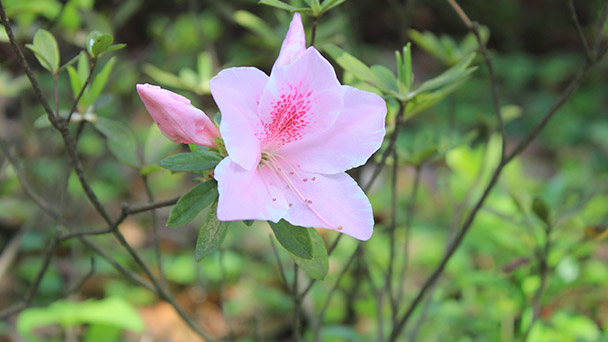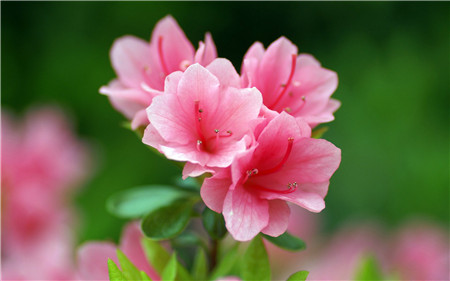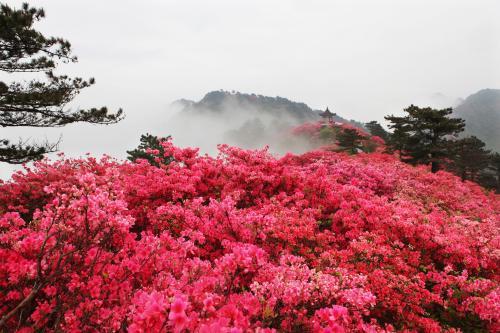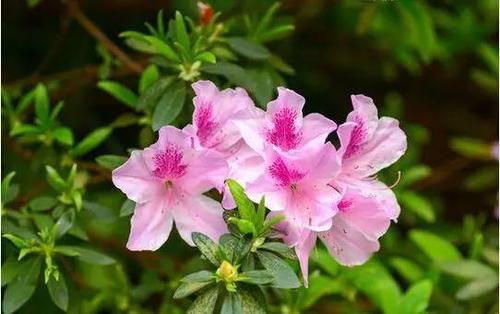Rhododendron Simsii Plant (Azalea) Care & Growing Guide
Written by Maggie
Dec 28 2022

As the first Rhododendron Simsii buds begin to form in the fall, watering should be reduced. From spring to fall, give your indoor azaleas fertilizer about every four weeks.
Rhododendron simsii plants prefer acidic soil and do not grow well or even do not grow in calcareous soil. So soil scientists often use rhododendron simsii as an indicator crop for acidic soils. Rhododendron simsii are fond of cool, humid and ventilated semi-shade environment, and are afraid of both heat and cold.
The optimum temperature for growth is 12℃ to 25℃. When the temperature exceeds 35℃ in summer, the new shoots and leaves grow slowly and are in a semi-dormancy state. Avoid sun exposure, and they are suitable for growing under scattering light.
Rhododendron Simsii Quick Info
Rhododendron simsii is an evergreen shrub, also known as azalea. Rhododendron simsii generally bloom in late winter and spring with 2-6 flowers in each cluster. The corolla is funnel-shaped and the flower colors vary from red, light red, apricot red, snow green, white and so on. Rhododendron simsii plants are born under sparse shrub or pine forest at an altitude of 500-1200 (-2500) meters.| Common name | Indoor Azalea |
| Botanical/Scientific name | Rhododendron Simsii |
| Plant Type | Evergreen; annual |
| Bloom Time | Winter, Spring, Summer; Blooms repeatedly |
| Flower Color | Red, pink, white, etc |
| Light Requirements | Semi-shade |
| Soil | Acidic, moist well-drained Soil |
| Toxicity | Parts of plant are poisonous if ingested |

Where to Grow Rhododendron Simsii (Azalea)
In winter, you can choose to grow Rhododendron Simsii plant indoors, but it is best to place it in a place that can accept astigmatism and has good ventilation. Except for other seasons in winter, try to place them outdoors for breeding, and the breeding environment should be as spacious as possible and have the effect of shading.
How to Care for Rhododendron Simsii
Rhododendron Simsii Planch plant is best to grow indoors in winter, and it is more suitable to be placed outdoors in other seasons. When caring for Rhododendron Simsii Planch, we should choose loose, well-drained soil; the flower pots can be purple sand pots; irrigation should be given once every seven to ten days; it can receive sufficient light, and sun shade in summer.Soil Care
Choose acidic soils with good drainage and good air permeability to grow Rhododendron Simsii. Do not choose more viscous or alkaline soils. Some varieties of Rhododendron Simsii Planch. are only suitable for mountain soils.

Watering
It is best if rainwater can be used for watering. We can also choose water from ponds or rivers for watering. For indoor farming, you usually choose tap water. You can let the tap water stand for an hour or two to release the chlorine in the water, and then give it to Rhododendron simsii Planch. Watering the plants. Watering is basically every seven to ten days during the growth period.
The cold season requires less watering because growth is at its lowest.
Rhododendron simsii are delicate to chlorine and other chemicals dissolved in water, so you should water your plants with chlorine-free water. Learn more about watering houseplants.
Make sure the pot has a drainage hole to keep the soil from becoming waterlogged, which can cause root-rot disease.
Fertilizer
The rhododendron simsii planch plant is a beautiful plant. Fertilizing is essential because the root system of the Rhododendron Simsii Planch plant is longer. Therefore, when applying fertilizer, liquid fertilizer with relatively low concentration should be selected, which can be applied every half a month to satisfy the development of Rhododendron Simsii Planch.
Humidity
The moderate humidity that Rhododendron simsii prefers. Misting the leaves can cause fungal infestation; avoid doing so.
For your Rhododendron simsii, place the pot on a tray of wet pebbles. See how to increase humidity for indoor plants using these methods.
Lighting Requirements
Rhododendron Simsii Planch is not very fond of light, and it is more suitable to develop in the center with shade. In spring and autumn, the light is not very harsh, and the Rhododendron Simsii Planch can survive.In case of strong light in summer, continuous shading is necessary to avoid sunburn of Rhododendron Simsii Planch. Even a long time without light will affect the development of Rhododendron Simsii Planch. Generally, the cultivation of Rhododendron Simsii Planch can be done in the middle of semi-light.
Temperature Care
Botanists have discovered that the best growth temperature of Rhododendron Simsii Planch is 12~25℃. In summer, it is necessary to move Rhododendron Simsii Planch to the cool and windy center.And to the cold winter, should enhance the light and warmth, perhaps according to the warm indoor winter.
Keep your Rhododendron simsii away from drafts that can be both hot and cold to prevent sudden temperature changes. Learn more about how to understand temperature for indoor plants.
Pruning
If the Rhododendron Simsii Planch is properly maintained, it is easy to show the scene of bursting the basin. Continuous trimming of Rhododendron Simsii Planch is necessary for the luxurant foliage of Rhododendron Simsii Planch.In this way, the shape of Rhododendron Simsii Planch can be continuously defaced, and the ventilation management of Rhododendron Simsii Planch can also be enhanced.
Flower Pots Choose
There are generally two types of flower pots to choose from, such as purple clay pots and mud pots. The flower pots made of this material have better air permeability and drainage, so Rhododendron Simsii Planch.
How to Repot Rhododendron Simsii Plant
Rhododendron simsii should only be repotted in the growing season if it is completely pot-bound, as this causes it to bloom more profusely.
Repotting shouldn't be done while a plant is in bloom because the shock of it can shorten the flowering time.
To avoid the soil becoming soggy, which can cause root-rot disease and ultimately cause your plant to die, use a pot that is one size larger and has a drainage hole.
A slightly acidic, organically dense, free-draining soil is ideal for Rhododendron simsii.
Rhododendron Simsii Pest & Diseases Control
In the process of growing and caring for Rhododendron Simsii Planch, if the maintenance is not proper, it may be the season of pests and diseases, and the occurrence of pests and diseases in Rhododendron Simsii Planch is not unusual. Rhododendron Simsii Planch is more prone to chlorosis than others. Brown spot disease, root rot disease, and beneficial insect is to present red spider, aphid to wait easily, need to know to be which kind of disease and insect pest only, simply choose reagents to have a target to be able!
Pests
Infestations of spider mites, scale insects, and nematodes are frequent pests of the Rhododendron simsii plant. To stop the infestation from spreading to other houseplants, isolate the affected plant and give it the proper pest treatment.
Diseases
Powdery Mildew, which causes the new leaves to curl, turn pale, then turn brown and die, is one of the common diseases that affect Rhododendron simsii plants. The plant should be thrown away since it won't survive.
Root rot caused by wet soil is another disease that affects Rhododendron simsii plants frequently. To avoid soggy soil, make sure the soil is free-draining and that the pot has a drainage hole.
Rhododendron Simsii Flowering Time
Rhododendron simsii flowering time is mainly based on the variety. Different varieties will bloom in different time in different climates. Generally, the most common flowering time is in spring, and the flowering time can last for 2 weeks. If the Rhododendron simsii flowers are well cared for, they can bloom for about a month.Under normal conditions, Rhododendron simsii bloom many times a year, at least three times. They can bloom in later winter, spring, summer, late spring and early summer.

How to Propagate Rhododendron Simsii
Propagate Rhododendron Simsii from Cutting
(1) Cutting time: according to the planting variety to choose a reasonable cutting time.
(2) Cuttage method: select the current year of not completely lignified branches or just lignified not long ago. Cut it off, cut off the base of the cutting leaves, the top leaves to retain about 4 pieces, into the water for cutting. Then use humus rich soil about the cutting substrate, keep the cutting surface mouth smooth, it will be inserted around the general. Cuttage after pouring permeable, film mulching to improve the moisture capacity of soil, promote cuttings rooting.
Propagate Rhododendron Simsii from Layering
(1) Layering time: the layering of Rhododendron Simsii Planch is mainly carried out at high altitude, usually around Tomb-sweeping Day.
(2) Layering method: choose sturdy branches that are about two years old and free from diseases and insect pests. Next in its specific upper part of the 11 cm or so place ring peel branches, peel off sieve tube, prevent nutrition to continue to transport down, tell nutrition concentrated in the ring peel place, promote the germination of root and bud. Then wrap the wet soil in a plastic bag or film, wrap it around the strip and tie the two ends of the bag tightly.Put it out of direct sunlight and manage it. Keep the soil in the bag moist to help the wound heal and root. At about 3 months, when the roots grow to about 3 cm, they can be separated from the mother plant to form a separate plant.
Propagate Rhododendron Simsii from Grafting
(1) Grafting time: Grafting reproduction is generally carried out around May each year.
(2) Grafting method: Rhododendron Simsii Planch plants born within two years were selected as rootstock, and the thickness of rootstock was not much different from that of scion. Then cut the young shoots about 4 cm from the mother plant, leaving about 4 leaves at the top, and cut the base of the young shoots into wedges. Then cut it short when the new shoot of the stock has grown to about 3cm, remove the leaves, cut them lengthwise by about 1cm, and then insert the scion to ensure that the cortex is aligned with it. Wrap and bind the joint with grafting film, and then cover the plastic bag for moisture, and put it in a shady place. After about a week or so, if you find water droplets inside the bag, you have a good chance of survival. Remove the bags after 60 days and untie the ropes the following spring.
Propagate Rhododendron Simsii from Seed
(1) Seed selection: When the seed color of Rhododendron Simsii Planch gradually turns brown, the top of the fruit is cracked, and the seeds fall out, it should be harvested in time. And there is no cracking can not be retained, put it in a cool and ventilated place for storage, to promote cracking.Remove impurities from the seeds after picking them up.
(2) Sowing time: Sowing is carried out in spring every year.
(3) Sowing method: do a good job of soil disinfection, in the time of sowing to properly mix in fine soil to improve the germination rate of seeds. When sowing, we should pay attention to the seeding density, and then cover a layer of fine soil after sowing, do a good job of management, and improve the germination rate of seeds.
Rhododendron Simsii Plant (Azalea) Common Problems
What Causes Rhododendron Simsii Plant Yellow Leaves With Green Veins
Rhododendron simsii's yellow leaves with green veins are an indication of nutrient deficiency caused by the soil's high alkalinity. Simsiis rhododendron prefers an acidic soil.
Every two to three weeks throughout the growing season, fertilize your Rhododendron simsii with a phosphorous-rich fertilizer made for plants that thrive in acidic environments.
Why Does My Rhododendron Simsii Plant Leaf Drop
Rhododendron simsii's leaf drop is caused by improper watering, such as under- or overwatering.
In order to prevent soggy soil, make sure the pot has a drainage hole and keep the soil moist at all times. Never allow the soil to even slightly dry out.
What Causes Rhododendron Simsii Plant Shrivelled Leaves
Underwatering or letting the soil get completely dry in between waterings in Rhododendron simsii will result in shriveled leaves.
Don't ever let the soil dry out; keep it moist at all times. Soak the ground to the point of saturation several times per week.
Why My Rhododendron Simsii Plant Have Yellow Leaves
Hard water should be used to water Rhododendron simsii; chlorinated water is not suitable for this plant.
As acid-loving plants, rhododendron simsiis shouldn't be watered with hard or chlorinated water. Water your Rhododendron simsii exclusively with distilled or rainwater.
Why My Rhododendron Simsii Plant Flower Bud Drop
Too dry air (low humidity) causes flower bud drop in Rhododendron simsii plants. Flower buds will shrivel, turn brown, and drop as a result of dry air.
A wet pebble tray should be placed on top of the pot to increase humidity while shielding your Rhododendron simsii from drafts. Consider using these methods to increase humidity for indoor plants.
Is Rhododendron Simsii Plant (Rhododendron Simsii) Toxic?
The rhododendron simsii plant is poisonous to both people and animals.
If consumed, it may result in a burning sensation in the mouth, drooling, vomiting, diarrhea, and fatigue. Keep pets and children away from Rhododendron simsiis.
Conclsuion: Rhododendron Simsii Care Tips
- Place in a ventilated place that can receive sunlight.
- Shading treatment: During the flowering period, sunshine can not be used for a long time, and appropriate shade should be used.
- Replace pot soil: Replace pot soil every two or three years, usually in autumn or after the flowers wither.
- Principle of pruning: timely pruning of broken branches and fallen leaves.
Latest Updated
- Benefits of Bugleweed - 7 Science-backed Health Benefits
- Bugleweed Dangers & Side Effects - Is It Poisonous?
- How to Plant Evergreen Trees - What You Should Know
- When to Plant Evergreens - Grow Guide for Evergreen Trees
- 12 Wonderful Evergreen Shrubs for Your Garden
- 12 Popular Evergreen Plants with Pictures for Beginners
- When And How To Prune A Lilac Bush Like a Pro
- How to Grow & Care for Lilac Vine (Hardenbergia Violacea)
- Japanese Lilac Tree (Syringa Reticulata) Care & Propagation Guide
- Shumard Oak Pros and Cons - What to Know
Popular Articles
- Winter maintenance of Antirrhinum Majus
- How to Grow Terminalia Mantaly Tree
- How to Grow and Care for Crossostephium Chinense
- How to grow Antirrhinum Majus in spring
- Peristeria Elata (Dove Orchid) Profile: Info & Care Guide
- Underwatered Snake Plant (Sansevieria Trifasciata) - Signs And How To Fix
- How to Care for Brazilian Jasmine Plant (Mandevilla Sanderi)
- How to Grow & Care for Graptopetalum Purple Delight in Summer
- Rosa Chinensis (China Rose): Plant Growing & Care Tips
- How to Care for Baby Sun Rose (Aptenia Cordifolia)